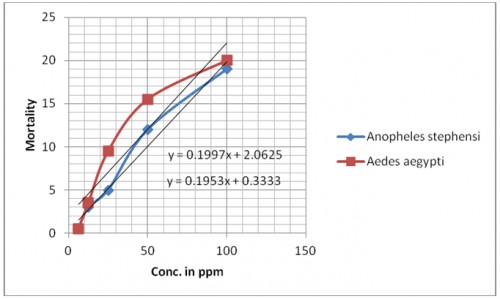Vol. 4, Issue 4, Part B (2017)
Chemical composition and bioefficacy for larvicidal and pupicidal activity of essential oils against two mosquito species
Author(s): Varun Tyagi, Ranjeet Patel, Hemanga Hazarika, Piyali Dey, Diganta Goswami and P Chattopadhyay
Abstract:
Mosquito species transmit major diseases viz. malaria, dengue, chikungunya, zika, filariasis and various forms of encephalitis; imposing enormous menace to human as well as animals. These diseases cause massive amount of morbidity and mortality across the world. The principal strategy for fighting against these diseases is the vector control including the use of larvicidal against mosquito larvae. Use of essential oils as mosquito larvicide has been suggested by different studies. Four samples of essential oil (EO) were tested for larvicidal as well as pupicidal activity against Anopheles stephensi and Aedes aegypti and subsequently analysed by gas chromatography- mass spectroscopy (GC-MS). Clove oil shows least LC50 and LC90 values for larvicidal as well as pupicidal activity against Anopheles stephensi species among the four EOs as 15.72ppm, 60.70ppm, for larvae; 46.47ppm, 80.66ppm, for pupae; 45.52ppm, 81.72ppm, against Aedes aegypti pupae. Whereas jasmine oil shows best results for larvicidal activity against Aedes aegypti larvae as 42.85ppm and 78.18ppm while it shows higher LC50 and LC90 of 73.52ppm, 399.05ppm against Anopheles stephensi larvae. Camphor oil shows high LC50 and LC90 values against Aedes aegypti larvae. It shows high LC50 and LC90 values against the both species as follows 178.60ppm and 309.7ppm Anopheles stephensi pupae and 218.08ppm and 388.29ppm Aedes aegypti pupae. All EOs showed moderate to high larval and pupal mortality against the both mosquito species except for camphor, which is least-effective among the others. EOs containing 1,3-ditert-butylbenzene, Linalool, Alpha copane, Artemisia ketone have showed satisfactory larvicidal as well as pupicidal activity . The results signifies that EOs may prove to be an eco-friendly alternative for the vector control in aquatic stages (larvae and pupae) with Anopheles stephensi and Aedes aegypti as the target species.
Mosquito species transmit major diseases viz. malaria, dengue, chikungunya, zika, filariasis and various forms of encephalitis; imposing enormous menace to human as well as animals. These diseases cause massive amount of morbidity and mortality across the world. The principal strategy for fighting against these diseases is the vector control including the use of larvicidal against mosquito larvae. Use of essential oils as mosquito larvicide has been suggested by different studies. Four samples of essential oil (EO) were tested for larvicidal as well as pupicidal activity against Anopheles stephensi and Aedes aegypti and subsequently analysed by gas chromatography- mass spectroscopy (GC-MS). Clove oil shows least LC50 and LC90 values for larvicidal as well as pupicidal activity against Anopheles stephensi species among the four EOs as 15.72ppm, 60.70ppm, for larvae; 46.47ppm, 80.66ppm, for pupae; 45.52ppm, 81.72ppm, against Aedes aegypti pupae. Whereas jasmine oil shows best results for larvicidal activity against Aedes aegypti larvae as 42.85ppm and 78.18ppm while it shows higher LC50 and LC90 of 73.52ppm, 399.05ppm against Anopheles stephensi larvae. Camphor oil shows high LC50 and LC90 values against Aedes aegypti larvae. It shows high LC50 and LC90 values against the both species as follows 178.60ppm and 309.7ppm Anopheles stephensi pupae and 218.08ppm and 388.29ppm Aedes aegypti pupae. All EOs showed moderate to high larval and pupal mortality against the both mosquito species except for camphor, which is least-effective among the others. EOs containing 1,3-ditert-butylbenzene, Linalool, Alpha copane, Artemisia ketone have showed satisfactory larvicidal as well as pupicidal activity . The results signifies that EOs may prove to be an eco-friendly alternative for the vector control in aquatic stages (larvae and pupae) with Anopheles stephensi and Aedes aegypti as the target species.
Related Graphics: Click here for more related graphics

Fig.: Mortality of pupae of Anopheles stephensi and Aedes aegypti against deodar oil after 24 hrs
Pages: 112-118 | 2287 Views 181 Downloads
How to cite this article:
Varun Tyagi, Ranjeet Patel, Hemanga Hazarika, Piyali Dey, Diganta Goswami, P Chattopadhyay. Chemical composition and bioefficacy for larvicidal and pupicidal activity of essential oils against two mosquito species. Int J Mosq Res 2017;4(4):112-118.







